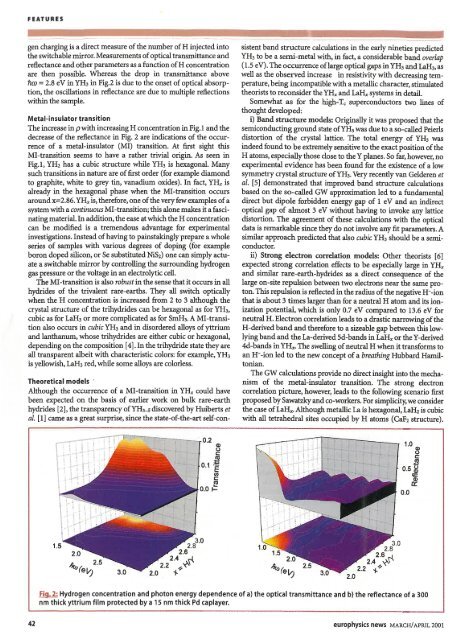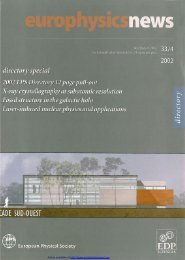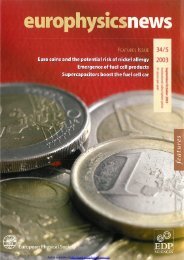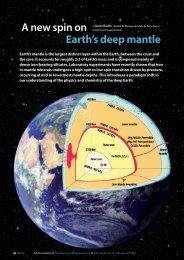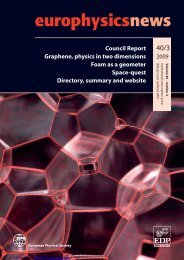Whole issue in PDF - Europhysics News
Whole issue in PDF - Europhysics News
Whole issue in PDF - Europhysics News
Create successful ePaper yourself
Turn your PDF publications into a flip-book with our unique Google optimized e-Paper software.
FEATURES<br />
gen charg<strong>in</strong>g is a direct measure ofthe number ofH <strong>in</strong>jected <strong>in</strong>to<br />
the switchable mirror. Measurements ofopticaltransmittance and<br />
reflectance and other parameters as a function ofH concentration<br />
are then possible. Whereas the drop <strong>in</strong> transmittance above<br />
tiro = 2.8 eV <strong>in</strong> YH3 <strong>in</strong> Fig.2 is due to the onset of optical absorption,<br />
the oscillations <strong>in</strong> reflectance are due to multiple reflections<br />
with<strong>in</strong> the sample.<br />
Metal-<strong>in</strong>sulator transition<br />
The <strong>in</strong>crease <strong>in</strong>pwith <strong>in</strong>creas<strong>in</strong>g H concentration <strong>in</strong> Fig.1 and the<br />
decrease of the reflectance <strong>in</strong> Fig. 2 are <strong>in</strong>dications of the occurrence<br />
of a metal-<strong>in</strong>sulator (MI) transition. At first sight this<br />
MI-transition seems to have a rather trivial orig<strong>in</strong>. As seen <strong>in</strong><br />
Fig. 1, YH2 has a cubic structure while YH3 is hexagonal. Many<br />
such transitions <strong>in</strong> nature are offirst order (for example diamond<br />
to graphite, white to grey t<strong>in</strong>, vanadium oxides). In fact, YHx is<br />
already <strong>in</strong> the hexagonal phase when the MI-transition occurs<br />
aroundx=2.86.YH x is, therefore, one ofthe veryfew examples ofa<br />
system with a cont<strong>in</strong>uous MI-transition; this alone makes it a fasc<strong>in</strong>at<strong>in</strong>g<br />
material.In addition, the ease atwhichthe H concentration<br />
can be modified is a tremendous advantage for experimental<br />
<strong>in</strong>vestigations. Instead ofhav<strong>in</strong>g to pa<strong>in</strong>stak<strong>in</strong>glyprepare a whole<br />
series of samples with various degrees of dop<strong>in</strong>g (for example<br />
boron doped silicon, or Se substituted NiS2) one can simplyactuate<br />
a switchable mirror by controll<strong>in</strong>g the surround<strong>in</strong>g hydrogen<br />
gas pressure orthe voltage <strong>in</strong> an electrolytic cell.<br />
The MI-transition is also robust <strong>in</strong>the sense that it occurs <strong>in</strong> all<br />
hydrides of the trivalent rare-earths. They all switch optically<br />
when the H concentration is <strong>in</strong>creased from 2 to 3 although the<br />
crystal structure of the trihydrides can be hexagonal as for YH3,<br />
cubic as for LaH3 or more complicated as for SmH3.A MI-transition<br />
also occurs <strong>in</strong> cubic YH3and <strong>in</strong> disordered alloys ofyttrium<br />
and lanthanum, whose trihydrides are either cubic or hexagonal,<br />
depend<strong>in</strong>g on the composition [4]. In the trihydride state they are<br />
all transparent albeit with characteristic colors: for example, YH3<br />
is yellowish, LaH3 red, while some alloys are colorless.<br />
Theoretical models .<br />
Although the occurrence of a MI-transition <strong>in</strong> YHx could have<br />
been expected on the basis of earlier work on bulk rare-earth<br />
hydrides [2], the transparency ofYH3-e5 discovered byHuiberts et<br />
al. [1] came as a great surprise, s<strong>in</strong>ce the state-of-the-art self-con-<br />
sistent band structure calculations <strong>in</strong> the early n<strong>in</strong>eties predicted<br />
YH3to be a semi-metal with, <strong>in</strong> fact, a considerable band overlap<br />
(1.5 eV). The occurrence oflarge optical gaps <strong>in</strong>YH3and LaH3' as<br />
well as the observed <strong>in</strong>crease <strong>in</strong> resistivity with decreas<strong>in</strong>g temperature,<br />
be<strong>in</strong>g <strong>in</strong>compatible with a metallic character, stimulated<br />
theorists to reconsider the YH x and LaH x systems <strong>in</strong> detail.<br />
Somewhat as for the high-Tc superconductors two l<strong>in</strong>es of<br />
thought developed:<br />
i) Band structure models: Orig<strong>in</strong>ally it was proposed that the<br />
semiconduct<strong>in</strong>g ground state ofYH3 was due to a so-called Peierls<br />
distortion of the crystal lattice. The total energy of YH3 was<br />
<strong>in</strong>deedfound to be extremely sensitive to the exact position ofthe<br />
H atoms, especiallythose close to theY planes. So far, however, no<br />
experimental evidence has been found for the existence of a low<br />
symmetrycrystal structure ofYH3.Very recendy van Gelderen et<br />
al. [5] demonstrated that improved band structure calculations<br />
based on the so-called GW approximation led to a fundamental<br />
direct but dipole forbidden energy gap of 1 eV and an <strong>in</strong>direct<br />
optical gap of almost 3 eV without hav<strong>in</strong>g to <strong>in</strong>voke any lattice<br />
distortion. The agreement of these calculations with the optical<br />
data is remarkable s<strong>in</strong>ce they do not <strong>in</strong>volve any fit parameters. A<br />
similar approach predicted that also cubic YH3should be a semiconductor.<br />
ii) Strong electron correlation models: Other theorists [6]<br />
expected strong correlation effects to be especially large <strong>in</strong> YH x<br />
and similar rare-earth-hydrides as a direct consequence of the<br />
large on-site repulsion between two electrons near the same proton.<br />
This repulsion is reflected <strong>in</strong> the radius ofthe negative H--ion<br />
that is about 3 times larger than for a neutral H atom and its ionization<br />
potential, which is only 0.7 eV compared to 13.6 eV for<br />
neutral H. Electron correlation leads to a drastic narrow<strong>in</strong>g ofthe<br />
H-derived band and therefore to a sizeable gap between this lowly<strong>in</strong>gbandandthe<br />
La-derived 5d-bands <strong>in</strong>LaH x orthe Y-derived<br />
4d-bands <strong>in</strong>YH x •The swell<strong>in</strong>g ofneutral H when ittransforms to<br />
an H--ion led to the new concept ofa breath<strong>in</strong>g Hubbard Hamiltonian.<br />
The GW calculations provide no direct <strong>in</strong>sight <strong>in</strong>to the mechanism<br />
of the metal-<strong>in</strong>sulator transition. The strong electron<br />
correlation picture, however, leads to the follow<strong>in</strong>g scenario first<br />
proposedbySawatzkyand co-workers. For simplicity;we consider<br />
the case ofLaH x•Although metallic Lais hexagonal, LaH2is cubic<br />
with all tetrahedral sites occupied by H atoms (CaF2 structure).<br />
1.0 &<br />
c:<br />
oS<br />
0.5 ~<br />
~<br />
0.0<br />
3.0<br />
2.8<br />
2.6<br />
2.4 ~<br />
2.2 ~~<br />
2.0 i-<br />
3.0<br />
2.8<br />
2.6 s-t<br />
2.4 '(\<br />
2.2 i-~<br />
2.0<br />
Fig. 2: Hydrogen concentration and photon energy dependence of a) the optical transmittance and b) the reflectance of a 300<br />
nm thick yttrium film protected by a 15 nm thick Pd caplayer.<br />
42<br />
europhysics news MARCH/APRIL 2001


